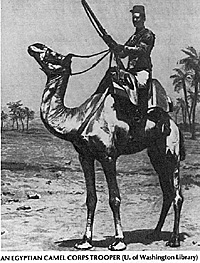 In 1892, Sir Herbert Kitchener replaced Grenfell as Sirdar of the
Egyptian army. He was Lord Cromer's (Sir Evelyn Baring became
Lord Cromer in 1892) personal choice-a first-class administrator,
meticulous in every military detail and very careful with monetary
expenditures.
In 1892, Sir Herbert Kitchener replaced Grenfell as Sirdar of the
Egyptian army. He was Lord Cromer's (Sir Evelyn Baring became
Lord Cromer in 1892) personal choice-a first-class administrator,
meticulous in every military detail and very careful with monetary
expenditures.
SIR HERBERT KITCHENER, THE SIRDAR (U. of Washington Library)
By 1896, Egypt found herself with two assets previously missing from her recent history-a surplus of money and an excellent army. In March of 1896, without consulting the British, the Khedive announced plans for the Egyptian re-occupation of the province of Dongola.
Surprisingly, the British did not disagree. Two events had helped London decide that the time was ripe for an advance into the Sudan. The Italians, who had recently suffered a disasterous defeat at the hands of the Abyssinians at the battle of Adowa, asked for a diversion to keep the Mahdists from recapturing Kassala, now weakened after Adowa. Secondly, intelligence pointed towards increased French incursions into the southern Sudan, previously claimed by Egypt (and, therefore, Britain).
The Dongola campaign was meticulously planned by Kitchener. Every possible detail, and cost, was carefully plotted out. Supply, always a problem when operating along the Nile, received extra special attention. From Cairo to Saras, a distance of 827 miles, transport was accomplished by (in order from Cairo) a railway (350 miles), river steamers (230 miles), a short railway around the first cataract (6 miles), river steamers again (208 miles) and a narrow gauge railway (33 miles). Beyond Saras, camel convoys protected by a series of fortified encampments would supply the troops while the railway was extended.
The first advance was made unopposed, to Akasha, 55 miles south of Saras on March 20, 1896. The Mahdists, 3,000 strong, chose to fortify themselves at Firka, sixteen miles further south.
For once the Khalifa's intelligence system failed him. Little information about Kitchener's force made its way to Uthman al-Azraq, the Mahdist commander. During the night of 6-7 June, Kitchener and his 9,000-man army moved on Firka.
 AN EGYPTIAN CAMEL CORPS TROOPER (U. of Washington Library)
AN EGYPTIAN CAMEL CORPS TROOPER (U. of Washington Library)
A desert column of cavalry, camel corps and horse artillery marched inland to cut-off the Mahdists' escape route. The bulk of the army, nearly 7,000 men, advanced along the Nile and attacked at dawn. When Uthman's outposts finally spotted the Egyptians and sounded the alarm, it was too late, the trap had been sprung. With complete surprise on his side, Kitchener steam- rolled through the outnumbered ansar. Mahdist casualties were 1,000 dead and 600 captured, including most of the emirs. Uthman al-Azraq and the shattered remnants of his army retreated further south. The Egyptian army lost 22 killed and 91 wounded.
Kitchener now paused for three months to await further reinforcements and the gunboat flotilla. In early September the army, now swollen to 13,000 men with 22 guns, and accompanied by four gunboats, was ready for the final advance to Dongola. The Mahdists, under Muhammad wad Bushara, had 5,600 men and six mountain guns with which to oppose Kitchener. Though outnumbered, Bushara's plan of action was quite sound. Knowing that the Egyptian army would have to cross the Nile somewhere to attack Dogola (which was on the opposite bank from Kitchener's force), Bushara chose the most likely point for such a crossing and entrenched his forces at Hafir, across the Nile from the village of Kerma.
When the Egyptians entered Kerma on September 19, they found the village deserted, but were shocked to see Bushara's men dug-in on the west bank of the Nile. Kitchener, not wanting to continue his march and leave over 5,000 hostiles in his rear, decided to blast the Mahdists out of their positions with artillery and gunboat fire. After several ineffectual hours of this bombardment, the Sirdar ordered a ceasefire and changed his plans. The gunboats were ordered to steam past the Mahdist entrenchments and on to Dongola.
Kitchener then spread rumors that the Egyptian army would continue its advance along the east bank of the Nile and cross further upstream, aided by the gunboats. The Khalifa's troops, fearful of an attack from their rear and concerned about the fates of their families in Dongola, abandoned their positions during the night.
Dongola fell without a fight on September 23rd. The Mahdist army disintegrated and fled southeast towards Metemmah, Berber and Atbara. The Dongola campaign was over. It had cost very little, either in lives or money. Kitchener, Cromer, the Khedive and the British government were all both pleased and impressed. Over 450 miles of the Nile had been recaptured at the cost of less than 170 battle casualties. The Mahdists had been defeated, outwitted and sent retreating in disorder towards Omdurman and the Khalifa.
More Sudan Part II
- The Khalifa Takes Control, 1885
The Invasion of Egypt, 1889
The Dongala Expedition, 1896
Advance to Omdurman, 1897
Battle of Omdurman, 1898
Back to Table of Contents -- Courier Vol. V #4
To Courier List of Issues
To MagWeb Master Magazine List
© Copyright 1984 by The Courier Publishing Company.
This article appears in MagWeb (Magazine Web) on the Internet World Wide Web.
Other military history articles and gaming articles are available at http://www.magweb.com